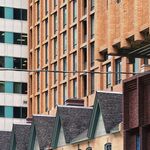Though realistically speaking (and sales, airplay, cultural ubiquity proves it), Yoko in and of herself remains an acquired-taste-at-best harder sell than John. And no amount of force-feeding will overcome that fact. "Imagine" vs "Fly". "Starting Over" vs "Walking On Thin Ice". "Popular" art vs "gallery" art, etc etc.
Perhaps the deeper point ought to be that while Yoko and her ilk aren't everybody's direct cup of tea, relatively few are
vehemently, pathologically against her at a level beyond the kinds of late-night comedy yoks (which even Yoko-heads can chuckle at, perhaps because they're just as much at the expense of Yoko-haters as Yoko-lovers.) To most, she's accepted as John Lennon's partner and muse and influence; and as an artistic creator, she's as benign as Christo at this point. She's "trickled down" sufficiently, to the point where those who brand her an unpalatable fringe quack are "fringier" (in the Toronto Sun-esque tyranny-of-the-majority sense) than she is. (Doesn't mean she's unworthy of a yet-broader meta-cultural critique--y'know, picking on the
middlebrowness rather than the fringiness of Yoko-worship at this point--but by its nature, such meta-critiquing conveniently cancels out its own absolutism, so Yoko still escapes the philistine's axe.)
Now, back to urbanism--and keep in mind that even a lot of architecture+planning's luminaries are prone to keeping a measured distance from PPS-to-the-letter (though the cynic might claim it's because they, themselves, are the target of such critiques). PPS may be great at offering guidelines for public space; but as judges of pre-existing urban space and form, they can fall victim to their own pathologically inflexible absolutism. Take, f'rinstance, their Public Space Enemy #1,
Boston City Hall Plaza. Is it so pure a "horror" and "failure"--and how much of that, in the end, is more a failure of programming and (this being AmeriKKKa)sociology, than of raw design? Is it such an unmitigated horror to those who've grown up with it (*knowing* how it was an award-winner, etc etc in its time) to the point of benign familiarity and even creative reverence? They say, "It conveys nothing in the way of information about Boston, its history, or its sense of place"--but duh, after four decades, it's *already* part of that, part of the elaborate Boston mosaic, and I'll betcha to a *real* (rather than PPS's preferred) "silent urban-conscious majority" accepted (or potentially acceptable) as such. Not that it can't use fine-tuning; but certainly not a demolish-everything-and-start-over boondoggle, which (lest we forget) is how this was all notoriously created in the first place (and more recently, the Big Dig's reminded Bostonians on how costly it can all be).
So, in extremis, it's Yoko-bashing, or maybe (esp. re the "urban renewal" element) like knocking hip-hop as a debased musical genre which lacks melody and what have you. Hip-hop is to music, as Boston City Hall Plaza is to urbanism--hey, if *someone* wants to frame things in that way, go ahead.
On that count, I'm a little worried as to the implications for Mississauga City Hall and its plaza--that is, w/PPS calling the shots, it may be facing a "tear down the NPS walkways" philistinism in the face...




